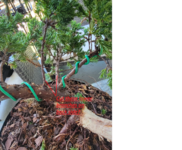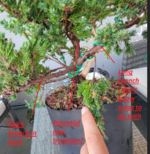jkennedy2316
Sapling
Location - Washington, D.C - Zone 8a.
I am brand new to bonsai. I apologize - this post is a little all over the place. I have questions that touch on specifics to this tree, but also broach on some other subjects that are more fundamental to a beginner bonsai journey.
This was my first real attempt at starting to clean and style any nursery stock. I wanted to check in with you all to see if I am thinking about next steps the right way. I included a bunch of annotated photos as well as the best screenshot I could find of the original stock before any cleaning was done.
Let me start with how we got here - then conclude with my strategy going forward to open up to critique.
I purchased this at the end of July. I did the first and only major work on it 8 days ago. I originally envisioned a cascade or semi-cascade as I started styling but I realized that might not work because of the dual trunk and how the branches were bending. I made the rather bold decision (perhaps too bold) to remove the entire other side and tilt the trunk at an angle for a more upright style with a pronounced jin feature. I know its not super traditional but I was trying to learn by doing and making mistakes.
Because of the jin making as well as having to dig through some of the top layer of roots to try and find the trunk base, I decided to put the scissors down even though the full cleaning/styling was not complete yet. I never removed the bonsai from the pot entirely, just broke up the top layer of roots. I noticed some very early signs of new growth on some branches which tells me this tree was pretty healthy considering how much I hacked away at it.
The branch that I believe is currently the leader has a very nice bend that was already in place with no wiring. At first I loved it - but the more I've had the chance to stare at this tree and consider long term strategy, I am starting to think it might not be the best branch to continue as the leader. I am just not sure how to approach this branch. It feels like I'm stuck between a semi-cascade or a half-assed nontraditional upright style if I continue with this branch. All of the other thicker, mature growth on the tree is behind that branch in the front. I don't think the current front branch gives me the best options for an apex.
Don't expecet anyone to answer all of these questions, but if anyone has insight on any of them I'd love to hear it.
Styling questions:
Long-term questions:
I am brand new to bonsai. I apologize - this post is a little all over the place. I have questions that touch on specifics to this tree, but also broach on some other subjects that are more fundamental to a beginner bonsai journey.
This was my first real attempt at starting to clean and style any nursery stock. I wanted to check in with you all to see if I am thinking about next steps the right way. I included a bunch of annotated photos as well as the best screenshot I could find of the original stock before any cleaning was done.
Let me start with how we got here - then conclude with my strategy going forward to open up to critique.
I purchased this at the end of July. I did the first and only major work on it 8 days ago. I originally envisioned a cascade or semi-cascade as I started styling but I realized that might not work because of the dual trunk and how the branches were bending. I made the rather bold decision (perhaps too bold) to remove the entire other side and tilt the trunk at an angle for a more upright style with a pronounced jin feature. I know its not super traditional but I was trying to learn by doing and making mistakes.
Because of the jin making as well as having to dig through some of the top layer of roots to try and find the trunk base, I decided to put the scissors down even though the full cleaning/styling was not complete yet. I never removed the bonsai from the pot entirely, just broke up the top layer of roots. I noticed some very early signs of new growth on some branches which tells me this tree was pretty healthy considering how much I hacked away at it.
The branch that I believe is currently the leader has a very nice bend that was already in place with no wiring. At first I loved it - but the more I've had the chance to stare at this tree and consider long term strategy, I am starting to think it might not be the best branch to continue as the leader. I am just not sure how to approach this branch. It feels like I'm stuck between a semi-cascade or a half-assed nontraditional upright style if I continue with this branch. All of the other thicker, mature growth on the tree is behind that branch in the front. I don't think the current front branch gives me the best options for an apex.
Don't expecet anyone to answer all of these questions, but if anyone has insight on any of them I'd love to hear it.
Styling questions:
- I am not sure what to do with the large bending branch in the front. It has nice natural movement, but the more time I've spent looking at it, I am starting to think it might be more limiting if it continues to guide the trunk shape . One Idea I had was to turn it into a creative jin feature to provide an offsetting deadwood perspective to the larger jin on the bottom of the tree.
- There are some branches lower in the trunk and behind the "current" front that I left on after the first styling. I don't think I will use them in any final styling, so the running advice I believe is to just prune. But I was sensitive about cutting too much green off after so much work. I am worried about potential reverse taper issues if I leave them in long-term, so perhaps its best to just cut entirely?
- There is another thick branch in the back that I am unsure what to do with. Open to suggestions.
- Wait until fall to wire? Does that still apply if I go with the jin route?
Long-term questions:
- Advice seems to be to wait until spring before a repot. Considering the extensive work that this tree has gone through, should I refrain from a half bare rooting and aim for 1/3 to repot into bonsai mix?
- I am not sure how to approach balancing the need to preserve foilage to recover from styling vs removing unnecessary growth that will divert energy from priority areas.







